Kitesurfing in the Outer Banks: A Complete Guide
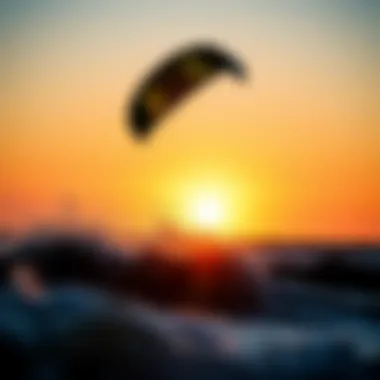
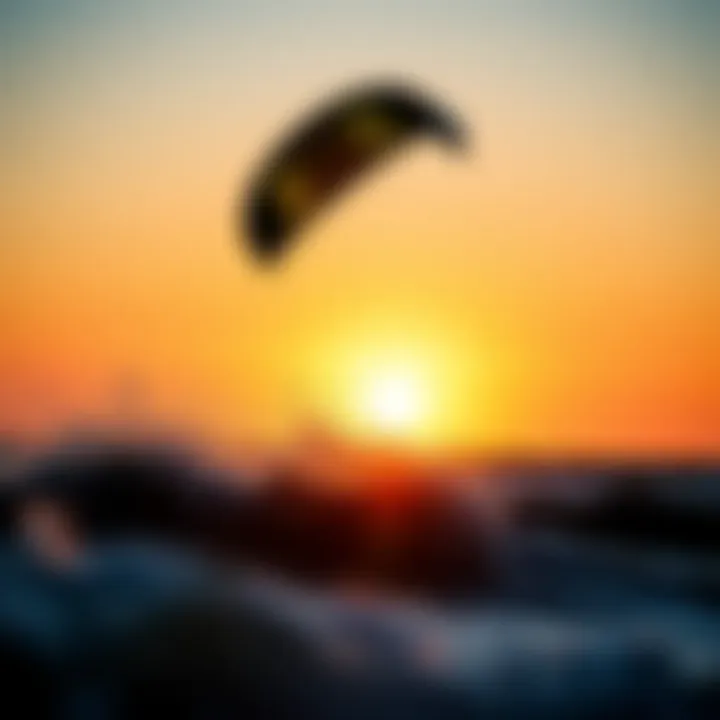
Intro
Kitesurfing in the Outer Banks offers not just a thrill but a deep connection to nature and community. Known for its vast stretches of sand and consistent winds, this destination attracts both novices and seasoned riders. The water is often flat, making it easier to learn and enjoy different styles of riding. Plus, the scenery? A picture-perfect backdrop of endless ocean and sunny skies. This guide is crafted to help you navigate the essentials of kitesurfing here, from the ideal gear to international safety norms and practical techniques. Whether you're planning your first session or looking to up your game, there's plenty to unpack.
Gear and Equipment
Essential Kiteboarding Gear for Beginners
For those just stepping onto the board, gear selection preps you for success. First off, you’ll need a dependable kite. Generally, a 9 to 12-meter inflatable kite works well for beginners, depending on your weight and wind conditions. A good starting kite will be stable and easy to control.
Next, don't forget a board suited for your skill level. A larger board provides more stability and makes it easier to catch the wind. Look for a twin-tip board—versatile and user-friendly.
Safety shouldn't be neglected either. A personal flotation device (PFD) is a must. Helmets, while not always required, are a good idea, particularly for beginners still honing their skills. It protects you against unexpected falls or collisions.
To summarize:
- Inflatable kite (9-12 meters)
- Twin-tip board
- Personal flotation device
- Helmet (optional but advisable)
Advanced Equipment for Experienced Riders
As you become more accustomed to the waves and wind, your needs will evolve. Experienced riders may look for kites with faster response times and the ability to perform jumps or tricks. Brands like NAISH and F-One offer high-performance kites tailored to freestyle or wave riding.
For boards, a lighter construction may be preferred, allowing for dynamic movement and extreme tricks. Additionally, consider a directional board if you're venturing into waves. These are fabulous for carving through surf but often come with a learning curve.
Don’t overlook harnesses either. A comfortable harness distributes the pull from the kite evenly. Look for a model that suits your riding style—whether it's seat-style or waist-style harnesses.
In summary, an advanced setup might include:
- Performance-oriented kite (e.g., from NAISH or F-One)
- Lightweight board designed for tricks
- Directional board for wave riding
- Well-fitted harness
Techniques and Tips
Basic Riding Techniques for Newbies
When you're just starting, mastering the basics is crucial. First up, get familiar with the wind and water conditions. Practice flying your kite on the beach before venturing out. This builds confidence and helps you understand how the kite reacts to wind changes.
Once you’re comfortable with kite handling, practice the "water start". Position the board under your feet while lying in the water, control the kite in a 2 o’clock or 10 o’clock position, and pull yourself up onto the board. Finding a sweet spot for the kite's position can help harness the power of the wind to lift you efficiently, allowing you to glide smoothly across the surface.
Expert Tricks to Elevate Your Skills
As your confidence blossoms, it’s time to push your boundaries. Jumping can be your next big adventure. To perform jumps, start with a solid speed and pop the board off the water by compressing your knees and using the power from the kite to lift. Timing matters, so practice makes perfect.
Additionally, mastering transitions can make your rides more enjoyable and fluid. Learning to shift from heel side to toe side seamlessly not only looks good but also prepares you for advanced maneuvers down the line.
End
Kitesurfing in the Outer Banks is more than a sport; it's a community, a lifestyle. With the right gear, techniques, and a little perseverance, it’s a journey waiting to unfold for all skill levels. The wind and waves are calling—are you ready to answer?
"The only thing standing between you and your goal is the story you keep telling yourself as to why you can't achieve it."
For further reading, visit Wikipedia or check out KiteForum for community discussions and tips.
Preface to Kitesurfing
Kitesurfing, an exciting water sport that merges elements of surfing, windsurfing, and paragliding, has gained significant traction over the past few decades. This exhilarating activity not only promises a rush of adrenaline but also fosters a deep connection with nature. For those considering venturing into this thrilling pastime, understanding its intricacies is paramount.
Defining Kitesurfing
At its core, kitesurfing involves riding on a board while being pulled by a large, controlled kite. This kite harnesses the power of the wind, allowing the rider to glide across the water’s surface with ease. Kites can range considerably in size, and each variant offers different performance characteristics, further reflecting the personal style and preferences of the rider. Unlike traditional surfing, where waves are essential, kitesurfing can be performed in a variety of conditions, making it versatile and accessible.
But it’s not just about having fun; safety and skill are fundamental. Riders need to master techniques like controlling the kite, understanding wind patterns, and timing their movements to maintain balance. With practice, kitesurfers develop a unique set of skills that enhance their experience, turning the ocean into their playground.
The Appeal of Kitesurfing
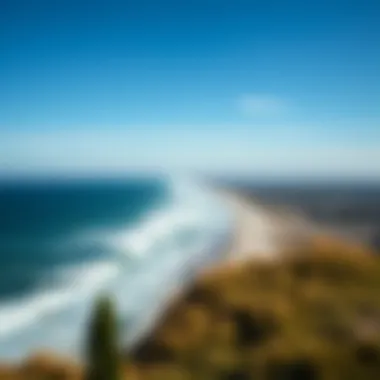
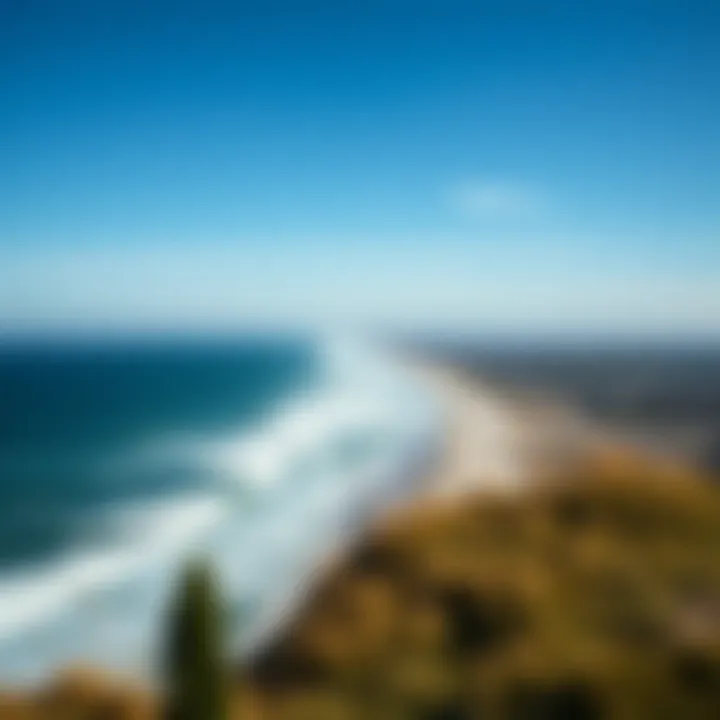
Several factors contribute to the allure of kitesurfing.
- Freedom on Water: There's an unmistakable sense of freedom that accompanies riding on the wind and waves. Kitesurfers often describe the experience as liberating, as they dance with the elements, harnessing wind energy and carving through the waves.
- Sense of Community: The kitesurfing community is a vibrant one. Meeting like-minded souls who share your passion can enrich the experience exponentially. Local spots, like those found in the Outer Banks, often host gatherings and events that cultivate camaraderie.
- Physical and Mental Benefits: Aside from being thrilling, kitesurfing offers significant health benefits. It enhances physical fitness, promotes mental clarity, and even provides a natural way to relieve stress.
Overall, the blend of adventure, community, and wellness found in kitesurfing creates an irresistible allure, especially in picturesque locations like the Outer Banks. In this guide, you'll find in-depth insights that will help you navigate the gear, techniques, safety, and local culture, ensuring a well-rounded experience in this exhilarating sport.
The Outer Banks: A Kitesurfer's Paradise
The Outer Banks is more than just a stretch of sandy shoreline; it's the beating heart of kitesurfing in the eastern United States. Located off the coast of North Carolina, this unique chain of barrier islands boasts an exceptional blend of geography and climate that attracts kitesurfers from all over the world. The allure of the Outer Banks lies in its pristine beaches, reliable wind patterns, and spacious waters, creating an environment where both beginners and seasoned riders can find their groove.
When one thinks of the Outer Banks, the imagery conjured could range from awe-inspiring dunes, panoramic views of the Atlantic, to wind-swept kites gliding across the horizon. This picturesque location not only offers breathtaking scenery but also provides the ideal conditions for the sport of kitesurfing. Riders can savor the feeling of freedom as they harness the wind and dance atop the waves.
The benefits of kitesurfing in this region are numerous, beginning with the diverse range of locations available for every skill level. From the shallow, flat waters of the sound, which is perfect for learning, to the more challenging ocean side for advanced maneuvers, the Outer Banks presents a playground for kitesurfers to explore.
Geography and Climate
The geographical layout of the Outer Banks plays a crucial role in shaping its reputation as a kitesurfing haven. This narrow, elongated chain of islands experiences unique winds due to its coastal position. The geography is characterized by maritime forests, expansive wetlands, and of course, miles of open beach.
The climate here is classified as humid subtropical, where summers are warm and winters are mild. The average temperature often lingers around a comfortable 75°F (24°C) during the peak kitesurfing season, which typically spans from late spring through early fall. What sets the Outer Banks apart is not just the warmth but the consistency of wind that laces through the area, providing ample opportunity for kitesurfing enthusiasts to practice.
In essence, the geography and climate create an environment that is almost tailor-made for the sport, vastly elevating the kitesurfing experience.
Wind Patterns and Conditions
Wind patterns in the Outer Banks are generally predictable, which is one of the key attractions for kitesurfers. Most commonly, the winds come from the east-southeast, providing consistent sessions that are essential for riders wanting to make the most out of their time on the water.
- Typical winds: You’ll usually find wind speeds averaging between 12-25 knots depending on the season. This range is perfect for kitesurfing, as it allows for various kite sizes and styles to be put to use effectively.
- Seasonal variations: During the summer months, breezes tend to pick up in the afternoons, while spring and fall may offer more stable winds throughout the day.
- Influence of storms: Occasionally, strong coastal storms can create swells and winds that challenge even the most seasoned riders. However, in many cases, these events contribute to exciting conditions but should always be approached with caution.
"Taking note of the wind conditions each day can make or break your kitesurfing experience in the Outer Banks. It’s not just about the gusts; it’s about knowing how to read the weather patterns."
Understanding these wind patterns and conditions is paramount to enjoying a successful day on the water. This knowledge not only contributes to overall safety but enhances the fun and thrill of kitesurfing, making your time at the Outer Banks unforgettable.
Essential Gear for Kitesurfing
When it comes to kitesurfing, the right gear is not just a suggestion; it’s essential for safety, performance, and overall enjoyment on the water. Having the right equipment can make the difference between a thrilling ride and a frustrating struggle. This section digs into the different pieces of gear that every kitesurfer needs, from novices to seasoned professionals. The importance of choosing the right equipment cannot be overstated, as it directly influences your experience and inevitably impacts your progression in the sport. Therefore, understanding what to look for when equipping yourself is critical.
Choosing the Right Kite
Selecting the right kite is one of the most vital choices you’ll make as a kitesurfer. The kite serves as your primary means of propulsion, and the wrong choice can lead to an exhausting experience on the water.
Firstly, consider the kite size. Kites come in various sizes, typically ranging from 5 to 20 square meters. As a rule of thumb, larger kites generate more power, which can be ideal for lighter wind conditions. Conversely, smaller kites are better suited for high winds. Think of it this way: if you're facing a gentle breeze, you wouldn't want a massive kite to drag you around like a rag doll.
Next, type of kite is another factor. The main types are C-kites, bow kites, and delta kites. C-kites offer better handling for experienced riders who need precision, while bow kites are generally forgiving and easier to learn with. Really, it comes down to your skill level and what you want to achieve.
Lastly, don’t ignore the materials. Look for kites made with durable fabrics and reinforced stitching. A kite should withstand the potential wear and tear from your sessions, especially if you plan to ride under harsher conditions. After all, your kite is your lifeline on the water.
Selecting the Board
A kitesurf board holds another crucial role in your riding experience. Think of it as your foundation. If you don't have a solid board that matches your skill level and riding style, your performance will likely suffer.
There are different types of boards tailored to various conditions. Twin-tip boards are most popular, as they allow for riding in either direction, making them user-friendly. On the other hand, directional boards act more like surfboards and are designed for specific riding styles, often utilized in waves. For someone eager to take on diverse conditions, a twin-tip board generally is the best starting point.
When picking a board, consider the size and shape. A larger board will give you a smoother ride and better upwind performance, especially if you’re just starting. Meanwhile, a smaller board can offer increased maneuverability but might require more effort to keep stable.
Finally, the weight of the board matters. A lighter board provides agility, making tricks easier, but may sacrifice a bit of stability. Finding the right balance for your unique style and conditions isn’t just wise, it’s a pathway to enjoying every moment on that board.
Safety Equipment
While the thrill of kitesurfing may take center stage, safety should never take a back seat. Proper safety equipment is essential for protecting yourself in unpredictable conditions.
First, invest in a reliable helmet. Even the most experienced riders can take a spill, and a helmet will protect your noggin from unforeseen bumps. Likewise, impact vests are a great idea, especially for those riding in choppier waters. They add an extra layer of protection against falls and impact.
Another important piece is the leash. This device attaches your kite to you—literally. A good leash will prevent you from losing your kite if you wipe out or face unexpected challenges. Make sure it's in good condition and never skimp on quality here; this is your safety tether.
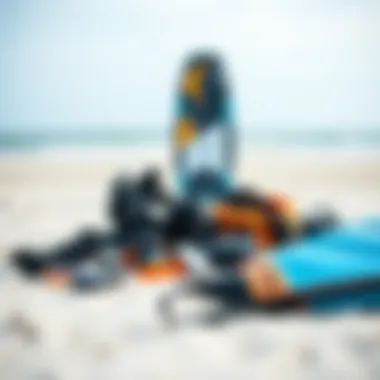
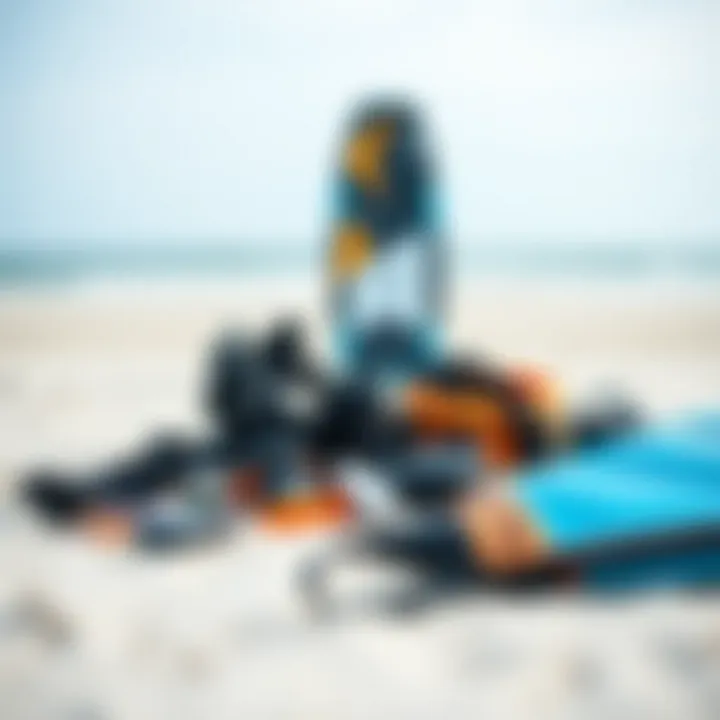
Lastly, know how to use the safety mechanism on your kite. Familiarity with how the safety features work, like depowering the kite or releasing it quickly, is essential. The wind can be unpredictable, and knowing your gear inside and out may be the thing that keeps your ride from turning into a ride from hell.
Remember, safe kitesurfers are happy kitesurfers. Taking the time to choose the right gear and understand its function is just as essential as selecting a beautiful spot like the Outer Banks.
Kitesurfing Techniques
Kitesurfing is not just about flying a kite and riding a board; it's an intricate dance between wind, water, and rider. Mastering kitesurfing techniques can markedly enhance the experience, unlocking a realm of skill that transforms a mere hobby into an art form. In this section, we’ll dive into both the basic techniques suited for beginners and the advanced maneuvers for those seasoned on the waves. Understanding these techniques is essential for safety, navigating different conditions, and truly enjoying one of the most exhilarating water sports.
Basic Techniques for Beginners
For those just starting out, understanding the foundational techniques is critical. The first step in kitesurfing is to become comfortable with the equipment. Here are some key aspects:
- Kite Control: Learning how to handle the kite is paramount. Beginners should first practice on land, flying their kites in low winds. This builds muscle memory and helps in understanding how different movements impact the kite’s position in the air.
- Body Positioning: A proper stance affects your balance. Position your body perpendicular to the wind direction, knees slightly bent, and arms extended to maintain grip on the control bar. Keeping your center of gravity low aids in stability.
- Launching and Landing the Kite: Getting the kite in the air can be tricky. It’s typically advised to have another person assist. Point the kite at a 45-degree angle to engage the wind and slowly let it rise. In terms of landing, keeping control and ensuring a clear space is crucial.
- Basic Riding Techniques: Once in the water, start with the 'body drag' technique, using the kite to pull you through the water. This helps with getting used to water resistance and balance before attempting to stand on the board. Eventually, you'll use the momentum from the kite to get up on the board and start riding.
"Practice makes perfect. Don’t rush; take your time to master each step."
Remember, the trick is to avoid everything feeling overwhelming. Break down each maneuver and practice until it feels instinctive. It's also wise to take lessons with qualified instructors who can guide you through these early stages, particularly in a varied landscape like the Outer Banks where conditions can change rapidly.
Advanced Techniques for Experienced Riders
As riders progress, there’s a desire to expand their skill set with more complex techniques that can add flair to their kitesurfing. Here are some that are sure to challenge experienced riders:
- Jumping and Tricks: This involves using the kite's power to leap off the water. Key points include:
- Kiteloops: A thrilling maneuver where riders loop the kite during jumps, creating a spectacular visual. This requires a good level of faith in your kite and ability to manage the tension in the lines.
- Surf Style Riding: Incorporating surfboard techniques into kitesurfing allows for incredible stylistic freedom. Catching waves, making sharp turns, and navigating obstacles turns riding into a more fluid dance on water.
- Switch Riding: This involves changing your stance mid-ride, which can be both challenging and rewarding. Mastering riding switch can elevate your skills, allowing for more dynamic movement and turns.
- Timing: Sending the kite upward just before reaching the peak of your jump can maximize height.
- Control: Once airborne, body positioning is key. Keep your body compact to reduce drag.
Engaging in these advanced techniques not only drives skill development but also creates a sense of community. Riders often share tips and tricks during encounters on the water, fostering a supportive environment to learn.
Safety Considerations
Kitesurfing is undoubtedly an exhilarating sport, but with excitement comes responsibility. Understanding safety considerations is key for any kitesurfer, regardless of experience level. The Outer Banks, with its breezy conditions and beautiful waters, can sometimes present unexpected challenges. Proper safety practices not only protect you, but also make the experience enjoyable for everyone around you.
Understanding Wind and Water Conditions
Before you even think of hitting the waves, gaining a solid grasp of wind and water conditions is as important as knowing how to ride. The Outer Banks are known for their diverse winds and varied water conditions. Knowing how to read these elements can mean the difference between a thrilling day of kitesurfing and a dangerous one.
- Wind Speed: Ideal wind speeds for kitesurfing usually range from 12 to 25 knots. Make sure to check the forecasts before you start, as conditions can change in the blink of an eye. Websites like Windy can provide real-time updates.
- Water Conditions: Be aware of currents and tides. In certain areas, they can carry a rider far away from their starting point. Understanding the local tides back at NOAA can help you plan your kitesurfing sessions effectively.
- Local Hazards: Familiarize yourself with local obstacles such as sandbars, rocks, or other kitesurfers. It’s vital to survey the area before launching.
Emergency Protocols
Despite prep and vigilance, accidents can happen. Knowing how to react can save lives or prevent severe injuries. Here are protocols applicable to kitesurfing emergencies:
- Equipment Failure: Always familiarize yourself with your gear and how to perform a quick release to detach from your kite if needed. Your safety harness should allow a straightforward escape from the kite’s pull.
- Distress Signals: In case you get into trouble, raising one arm above your head, waving it side-to-side signals distress. This lets other kitesurfers or beachgoers know you require assistance.
- Buddy System: Whenever possible, kitesurf with a partner. A buddy not only enhances your safety but allows for shared learning and fun.
- Emergency Contacts: Keep your phone accessible in a waterproof case, and if you're in a remote area, know the location of the nearest emergency services.
"Safety is paramount in kitesurfing. Be prepared, stay aware, and don’t take unnecessary risks."
By incorporating these practices and understanding your environment, you're not only looking out for your own safety but also fostering a healthier kitesurfing community. The Outer Banks provide an unforgettable experience, and ensuring safety enhances the fun for all.
Local Kitesurfing Schools and Lessons
When entering the world of kitesurfing, having the right guidance can make all the difference. Local kitesurfing schools in the Outer Banks play a pivotal role in shaping the experiences of both beginners and seasoned pros. It isn't just about learning the ropes; it’s about immersing oneself into a community that thrives on shared passions and collective progression. The Outer Banks, known for its wind conditions and scenic beaches, offers several schools that cater to various skill levels.
Popular Schools in the Outer Banks
Several notable kitesurfing schools dot the coastline of the Outer Banks. Each comes with its unique flavor and approach to teaching. Here are a few recognized names:
- Kitty Hawk Kites: As one of the oldest and most respected schools, they offer a wide range of courses from beginner to advanced. Their experienced instructors ensure the utmost safety while fostering a fun learning environment.
- Kitesurf OBX: This school prides itself on personalized instruction. Small group sizes allow for customized lessons tailored to individual needs, making it an excellent choice for those wanting extra attention.
- Hatteras Island Kitesurfing: Located in the heart of the Outer Banks, this school leverages the pristine conditions of Hatteras for an ultimate kitesurfing experience. Known for its focus on advanced techniques, it helps riders push their limits in a supportive atmosphere.
Choosing the right school often depends on one's individual preferences, be it the instructor’s teaching style or the type of equipment provided.
Types of Lessons Offered
Most kitesurfing schools in the Outer Banks offer a variety of lessons to cater to different skill levels. Here’s a breakdown that covers the usual offerings:
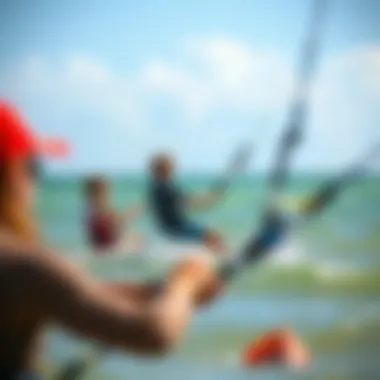
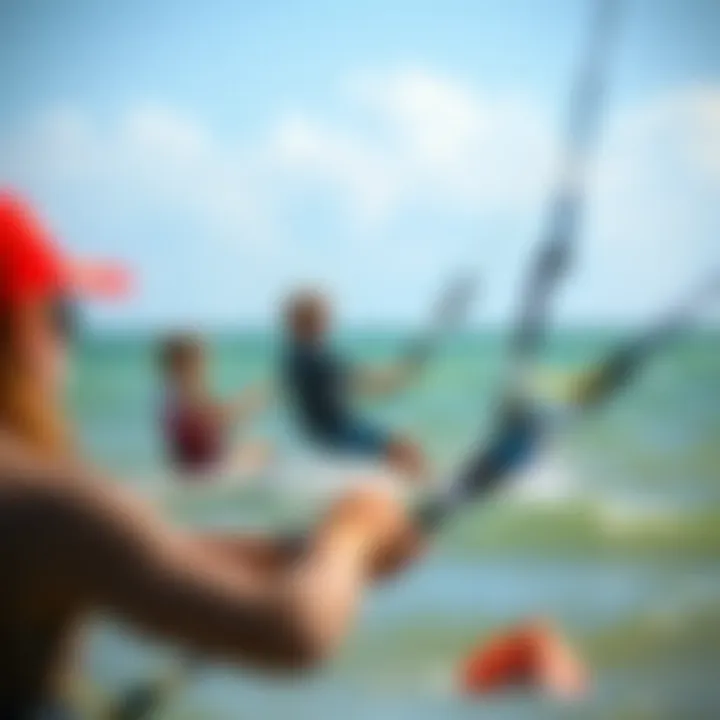
- Introductory Lessons: Ideal for absolute beginners. These sessions usually include an overview of equipment, safety protocols, and basic kite flying techniques. The goal here is to build confidence before hitting the water.
- Intermediate Sessions: For those who have mastered the basics, these lessons focus on refining techniques and introducing the mechanics of jumps and tricks. Instructors often emphasize safety and control during variable wind conditions.
- Advanced Coaching: These classes are designed for riders who want to take their skills to the next level. It could include mastering complex tricks or even learning how to ride in challenging environments. It’s all about pushing boundaries and gaining new insights.
- Private Lessons: One-on-one instruction for personalized learning experiences. This option is perfect for students seeking specific skills or focusing on particular areas of improvement.
- Group Lessons: These foster camaraderie among students and often come at a lower cost. It’s a chance to learn alongside friends or new acquaintances who share the same goal of becoming proficient kitesurfers.
Engaging in lessons at local schools not only equips you with the necessary skills but also instills respect for the water and the environment. The Outer Banks’ unique landscape and prevailing winds create an ideal learning playground, making it a destination where kiteboarders can grow and thrive together.
"There's no substitute for hands-on learning, especially with a sport as dynamic as kitesurfing. Local schools bring experience and community that can transform a single ride into a passion for life."
For further details about kitesurfing schools and lessons, visit Kitty Hawk Kites, Kitesurf OBX, and Hatteras Island Kitesurfing. These resources can help you connect with the right instructors to kickstart your kitesurfing journey in the Outer Banks.
Community and Culture of Kitesurfing
Kitesurfing is not just a sport; it's a thriving lifestyle choice that has fostered a unique community, especially in the Outer Banks. The blend of wind, water, and shared passion has created a vibrant culture that goes beyond the thrill of riding waves. This community aspect is crucial to kitesurfing, as it offers support, friendship, and shared experiences that elevate the sport itself.
Kiteboarding Events in the Outer Banks
The Outer Banks hosts a variety of kiteboarding events throughout the year. These gatherings are not merely competitions; they're celebrations of the sport that bring together enthusiasts from all walks of life. Events like the Kiteboarding 4 Cancer and the OBX Kiteboarding Festival showcase not only skilled riders but also the heart and camaraderie present within this culture.
These events often include:
- Competitions that cater to different skill levels ranging from amateurs to seasoned pros.
- Workshops and clinics where riders can learn from experts and improve their skills.
- Social gatherings that encourage mingling among kitesurfers, fostering connections that can last well beyond the event days.
Participating in these activities gives newcomers a chance to mingle and absorb the culture, while veterans can share their experiences and pass on valuable knowledge. It’s in these moments that stories are shared, friendships are formed, and the spirit of kitesurfing truly shines.
Connecting with Other Kitesurfers
Establishing connections within the kitesurfing community can significantly enhance your experience. Whether you are a seasoned rider or just starting out, having a network of fellow enthusiasts can lead to shared insights, equipment swaps, and often, great local tips. Online forums like reddit.com/r/kitesurfing or local social media groups on platforms such as facebook.com can be valuable resources for finding fellow kitesurfers. These connections can become your portal to understanding the best spots, not just for kitesurfing but for the overall Outer Banks experience.
Getting involved in local kitesurfing schools or clubs can also facilitate these connections. Engaging in group lessons allows for practical experience while creating bonds through shared learning. Moreover, many shops and schools organize meet-ups, which can be a fantastic way to learn more about the sport while enjoying the company of like-minded individuals.
"The wind, the water, and the kites bring us together—it is the ride that makes us family."
In summary, the community and culture surrounding kitesurfing in the Outer Banks is a vital element that not only enhances the kitesurfing experience but also embodies the essence of the sport itself. By engaging in events and connecting with fellow kitesurfers, one can enrich their adventure and create lasting memories.
Environmental Impact of Kitesurfing
Kitesurfing, while exhilarating, isn’t just about the thrill of gliding over the waves; it has a real impact on the environment, particularly in sensitive areas like the Outer Banks. Understanding this impact is crucial for responsible participation in the sport. There’s a balance to strike between enjoying nature and protecting it, and this section delves into the importance of minimizing our footprint while kitesurfing.
Protecting Natural Resources
The Outer Banks is famed for its stunning scenery and diverse ecosystems. This fragile habitat is home to numerous species of wildlife, some of which can become impacted by increased human activity. Kitesurfing can inadvertently lead to disturbances in these natural areas, affecting marine life and coastal environments.
A few vital points to consider include:
- Wildlife Disturbances: Keep an eye out for nesting areas, especially during breeding seasons. Birds or turtle nests can be easily disturbed by kitesurfing activity.
- Coastal Erosion: Beaches can wear down quicker under heavy use. This erosion can affect local flora and fauna, as well as the humans who enjoy these spots.
- Water Quality: Oil and debris from kitesurfing gear can pollute the waters. Always check for leaks in your equipment.
Using sustainable practices helps ensure the conservation of these precious resources before it’s too late.
Sustainable Practices for Kitesurfers
To combat the negative environmental impacts of kitesurfing, adopting sustainable practices is essential. Not only does this preserve the beauty of the Outer Banks, but it also enriches the overall kitesurfing experience. Here are some effective sustainable practices:
- Leave No Trace: After your kitesurfing session, make it a habit to clean up any trash you find. Whether it's yours or not, it enhances the environment for everyone.
- Eco-Friendly Gear: Opt for kitesurfing gear made from sustainable materials. Look for companies committed to environmentally friendly manufacturing.
- Stay Designated Areas: Stick to areas designated for kitesurfing, and avoid sensitive habitats, especially when you see signs indicating protected wildlife areas.
- Educate Yourself and Others: Share information about the importance of protecting the environment among fellow kitesurfers. Creating awareness can lead to collective action.
- Participate in Clean-Up Events: Many local kitesurfing communities organize beach clean-ups. Joining one can foster community spirit while positively impacting the coast.
"A clean ocean is a happy ocean."
The simple act of participating in preserving our shores can preserve the thrill of kitesurfing for generations to come.
By embracing these sustainable practices, kitesurfers can play a fundamental role in preserving the natural beauty of the Outer Banks, ensuring that this paradise remains available for all who seek adventure on the water.
The End
Wrapping up the exhilarating journey through kitesurfing in the Outer Banks, it’s clear that this sport is more than just a fleeting thrill. It embodies a lifestyle that dances with the wind and harmonizes with the sea. The beaches here not only serve as a backdrop but as an essential component of the kitesurfing experience. Neutral zones where the wind whispers and the waves call are vital for both beginners and seasoned pros alike.
Embracing the Kitesurfing Experience
To embrace kitesurfing is to immerse oneself in a world where adventure meets tranquility. The Outer Banks caters to a diverse crowd, offering countless spots that fit every skill level. From the serene shores of Hatteras Island to the bustling environment at Kitty Hawk, each location has its own unique charm.
- Training and Growth: Enrolling in local schools not only provides lessons but also a bonding experience with fellow kitesurfers. This shared journey deepens one’s connection with the sport, as friends and mentors guide newcomers through the challenge of riding the wind.
- Community Engagement: Being part of the kitesurfing culture entails participating in local events or simply dropping by the beach to witness friendly competitions. The kinship among kitesurfers transforms casual riders into a family of enthusiasts.
- Nature's Playground: As one takes to the blue, there’s a certain rhythm that kicks in. It’s not just about mastering techniques, but rather a communion with the environment. Every swell and gust becomes a teacher, nudging riders to respect and cherish the natural beauty around them.
"In every gust of wind, there lies the spirit of adventure. Each wave that breaks under your board tells a tale of resilience and joy."
To sum up, to embrace kitesurfing in the Outer Banks is to open oneself up to new experiences. It fosters a sense of adventure, offers the chance for personal growth, and creates a lasting community connection. As you take that initial step onto the sand, remember that you’re embarking not just on a sport, but a way of life.
Explore resources at Kiteboarding.com, or engage with fellow enthusiasts on Reddit. These communities can guide your journey and provide insight, ensuring you don’t navigate the waves alone.















